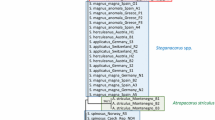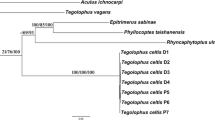Abstract
Two members of the floating fern genus Salvinia (Salviniaceae), S. minima Baker and S. molesta Mitchell, have established in the United States. Cyrtobagous salviniae Calder and Sands (Coleoptera: Curculionidae), long established on Florida S. minima, was released in Texas and Louisiana as a biocontrol agent for both species. Subsequently, sequence analysis of the 28S rRNA D2 expansion domain suggested that the Florida and Brazilian populations (used worldwide for biocontrol) of C. salviniae might constitute two cryptic species. In response, the Brazilian weevil was imported from Australia and released instead onto S. molesta. We sampled C. singularis Hustache and C. salviniae from their native ranges in Brazil, Argentina, and Paraguay and sequenced them (D2) along with Australian and Florida samples. The genetic distance between C. singularis and C. salviniae samples is much greater (almost 5×) than the distance between either the Florida and Brazilian samples or the Brazilian and Argentinean/ Paraguayan C. salviniae samples. Since C. singularis and C. salviniae are cryptic species, the Florida and Brazilian populations (or for that matter Brazilian and Argentinean/Paraguayan) could reasonably be described as demes or ecotypes. Occurrence data indicates that, in parts of their ranges, C. salviniae and C. singularis are not only sympatric but also feed on the same plant species at the same site. While host adaptation (species preferences) likely occurs within local demes, both species seem capable of adapting to the available resource (Salvinia species). Finally, a polymerase chain reaction (PCR) primer was developed to distinguish the Florida and Brazilian/Australian types.
Similar content being viewed by others
References
Abbasi S.A. and Nipaney P.C. (1986). Infestation by aquatic weeds of the fern genus Salvinia: Its status and control. Env. Cons. 13: 235–241
Berlocher S.H. and Feder J.L. (2002). Sympatric speciation in phytophagous insects: moving beyond controversy?. Annu. Rev. Entomol. 47: 773–815
Bush G.L. (1969). Sympatric host race formation and speciation in frugivorous flies of the genus Rhagoletis (Diptera: Tephritidae). Evolution 23: 237–251
Bush G.L. (1992). Host race formation and sympatric speciation in Rhagoletis fruit flies (Diptera: Tephritidae). Psyche 99: 335–355
Calder A.A. and Sands D.P.A. (1985). A new Brazilian Cyrtobagous Hustache (Coleoptera: Curculiondae) introduced into Australia to control Salvinia. J. Aust. Ent. Soc. 24: 57–64
Campbell B.C., Steffen-Campbell J.D. and Werren J.H. (1993). Phylogeny of the Nasonia species complex (Hymenoptera:Pteromalidae) inferred from an internal transcribed spacer (ITS2) and 28s rDNA sequences. Insect Mol. Biol. 2: 225–237
(1962). Contribución al conocimiento de las Salviniaceae neotropicales. I. Salvinia oblongifolia Martius, II. Salvinia auriculata Aublet, III. Salvinia herzogii nov. sp. Darwiniana 12: 465–520
Diehl S.R. and Bus G.L. (1984). An evolutionary and applied perspective of insect biotypes. Annu. Rev. Entomol. 29: 471–504
Drès M. and Mallet J. (2002). Host races in plant-feeding insects and their importance in sympatric speciation. Phil. Trans. Roy. Soc. Lond. B 357: 471–492
Forno I.W. (1983). Native distribution of the Salvinia auriculata complex and keys to species identification. Aquat. Bot. 17: 71–83
Gillespie J.J., Munro J.B., Deraty J.M., Yoder M.J., Owen A.K. and Carmichael A.E. (2005). A secondary structural model of the 28S rRNA expansion segments D2 and D3 for Chalcidoid wasps (Hymenoptera: Chalcidoidea). Mol. Biol. Evol. 22: 1593–1608
Goolsby J.A., Tipping P.W., Center T.D. and Driver F. (2000). Evidence of a new Cyrtobagous species (Coleoptera: Curculionidae) on Salvinia molesta Baker in Florida. Southwestern Entomologist 25: 299–301
Jacono C.C. (1999). Salvinia molesta (Salviniaceae) new to Texas and Louisiana. Sida 18: 927–928
Jacono C.C., Davern T.R. and Center T.D. (2001). The adventive status of Salvinia minima and S. molesta in the southern U.S. and the related distribution of the weevil Cyrtobagous salviniae. Castanea 66: 214–226
Jaenike J. (1981). Criteria for ascertaining the existence of host races. Am. Nat. 117: 830–834
Johnson D. (1995). Giant Salvinia found in South Carolina. Aquatics 17: 22
(1998). Biological control of weeds. A World Catalogue of Agents and Their Target Weeds. CABI Publishing, Wallingford, United Kingdom
Kissinger D.G. (1966). Cyrtobagous Hustache, a genus of weevils new to the United States fauna (Coleoptera: Curculionidae: Bagoini). The Coleopterist’s Bulletin 20: 125–127
Landry G.P. (1981). Salvinia minima new to Louisiana. Amer. Fern J. 68: 95
Madeira P.T., Jacono C.C., Tipping P., Van T.K. and Center T.D. (2003). A genetic survey of Salvinia minima in the southern United States. Aquat. Bot. 76: 127–139
Mitchell D.S. and Thomas P.A. (1972). The Kariba Weed: Salvinia molesta. Br. Fern Gaz. 10: 251–252
Mitchell, D.S. and P.A. Thomas, 1972. The Taxonomy and Distribution of Salvinia Species in the Neotropics. Ecology of Water Weeds in the Neotropics. Technicial papers in Hydrology 12. UNESCO, Paris, France.
Sands, D.P.A. and M. Schotz, 1985. Control or no control: A comparison of the feeding strategies of two Salvinia weevils. In: Proceedings of the VI International Symposium on Biological Control of Weeds, Vancouver, Canada, August, 1984, Agriculture Canada, Toronto, Ontario, Canada. pp. 551–556.
Sands D.P.A., Schotz M. and Bourne A.S. (1986). A comparative study on the intrinsic rates of increase of Cyrtobagous singularis and C. salviniae on the water weed Salvinia molesta. Entomol. Exp. Appl. 42: 231–237
Small J.K. (1931). Ferns of Florida: Being Descriptions of and Notes on the Fern-Plants Growing Naturally in Florida (illustrated). The Science Press, New York, 190–193
Swofford D.L. (2001). PAUP. Phylogenetic analysis using parsimony (and other methods). Version 4.0 Beta 10. Sinauer, Sunderland, Mass
Thompson J.D., Gibson T.J., Plewniak F., Jeanmougin F. and Higgins D.G. (1997). The ClustalX windows interface: flexible strategies for multiple sequence alignment aided by quality analysis tools. Nucl. Acids Res. 24: 4876–4882
Tipping P.W. and Center T.D. (2003). Cyrtobagous salviniae (Coleoptera: Curculionidae) successfully overwinters in Texas and Louisiana. Florida Entomol. 86: 92–93
Via S. (1990). Ecological genetics in herbivorous insects: the experimental study of evolution in natural and agricultural systems. Annu. Rev. Entomol. 35: 421–446
Walsh B.D. (1864). On phytophagic varieties and phytophagic species. Proc. Entomol. Soc. Phil. 3: 403–430
Author information
Authors and Affiliations
Corresponding author
Rights and permissions
About this article
Cite this article
Madeira, P.T., Tipping, P.W., Gandolfo, D.E. et al. Molecular and morphological examination of Cyrtobagous sp. collected from Argentina, Paraguay, Brazil, Australia, and Florida. Biocontrol 51, 679–701 (2006). https://doi.org/10.1007/s10526-005-5271-1
Received:
Accepted:
Published:
Issue Date:
DOI: https://doi.org/10.1007/s10526-005-5271-1




